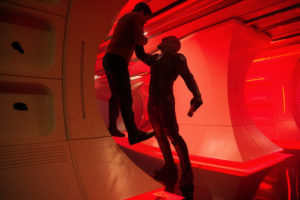
The third in the latest Star Trek franchise reboot, Star Trek Beyond, brings back the old cast of characters and the new actors that play them including Captain James T. Kirk (played by Chris Pine), Commander Spock (Zachary Quinto), Sulu (John Cho), Lieutenant Uhura (Zoë Saldana), Doctor ‘Bones’ McCoy (Karl Urban), Montgomery ‘Scotty’ Scott (Simon Pegg), and the recently-passed Anton Yelchin returned to his role as Pavel Chekov.
The plot of the movies centers around the Star Trek crew’s need to defend themselves from a hostile alien named Krall (Idris Elba) on a hostile alien world found within a nebula. The crew is assisted by the formidable character Jaylah (played by Sofia Boutella).
While it’s fairly clear that the “Beyond” title is primarily meant as a reference to traveling within a new part of space, the opening of the film suggests a deeper emergence is meant to occur. In the opening scenes, we learn the crew is on year 3 of their 5-year mission and Kirk is feeling self-doubt about his reasons for joining Starfleet, and he says his life is becoming too “episodic.” He’s considering a way out of the captain’s chair (and we later learn Spock is also considering a role beyond Starfleet). From the start, the viewer is led to believe this Star Trek movie is going to do something different, that it will go beyond the formulaic storylines we’ve seen in previous television episodes and other Star Trek films.
If that was the goal, they didn’t really nail it! Rather it’s clear the Hollywood-blockbuster machine still dictated how the story had to unfold. There must be a sequence with the destruction of a lot of buildings. There must be fights between a good guy and one of the villains. The Star Trek villain must be motivated by a typical grudge of some kind. There must be moments of humor, often relying on the relationships built by the original series. There must be a bit of sex or romance thrown in for good measure. And of course, millions of lives need to be in danger, but shown in a way that preserves the profitable PG-13 rating.
While the movie ends with a feeling the crew can now explore new depths of space, and while both Kirk and Spock have moments of transcendence and growth, the viewer is left wondering: How did this movie go above and beyond what we’ve seen before?
That being said, it did feel more like an episode than the previous 2 films in the Kelvin timeline. We’re reaching the point in this timeline where we have seen enough to recognize the differences and cheer on the personal improvements of the Kevlin timeline crew. With a couple nods to the past (and a really poignant scene with Spock – if you’ve seen it you know which one I mean), it satisfies the Trekkie in me.
Read a professional review of Star Trek Beyond from http://www.nytimes.com/2016/07/22/movies/review-star-trek-beyond.html
~Steven Hold
